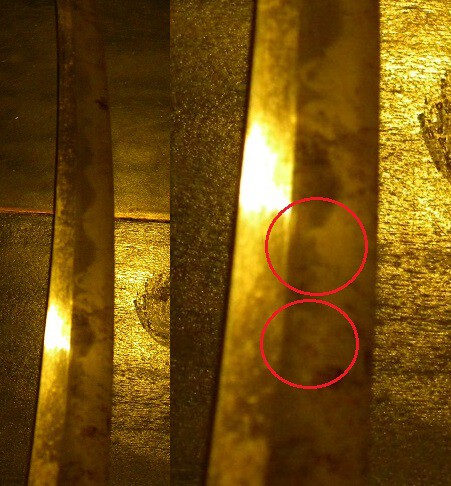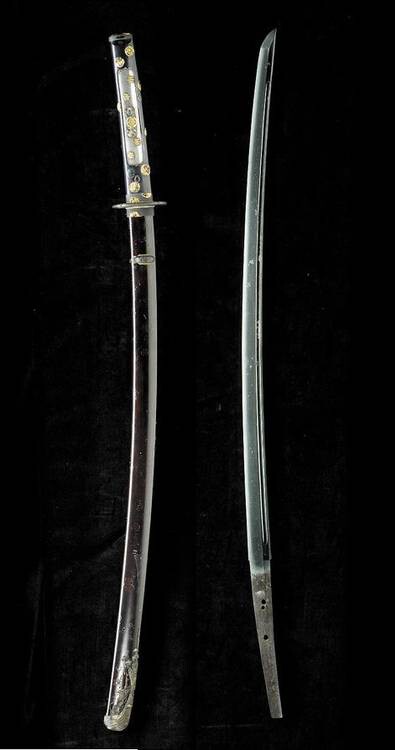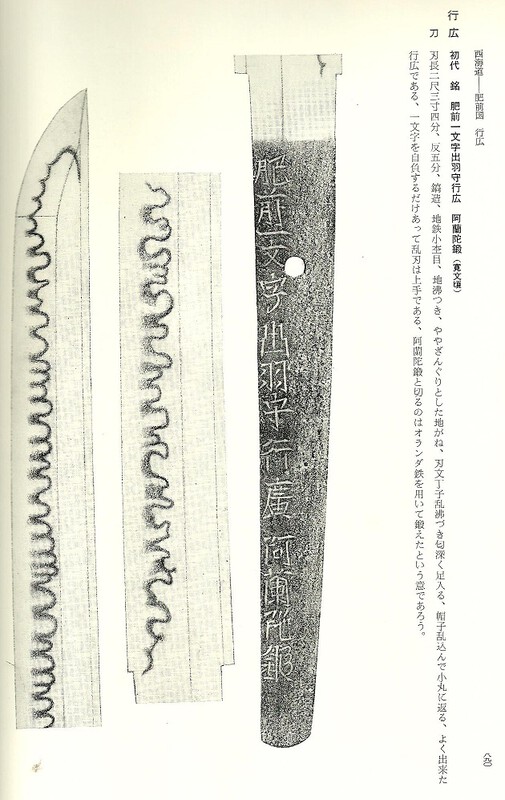
mdiddy
Dealers-
Posts
638 -
Joined
-
Last visited
-
Days Won
1
Content Type
Profiles
Forums
Events
Store
Downloads
Gallery
Everything posted by mdiddy
-
Stephen, Thanks for sharing. I enjoyed the documents on NT and IAO you compiled from the Nat'l archives here: http://www.militaria.co.za/articles/WW2_Archives.pdf. It made for some very interesting reading and interpretation of typos. I could not find any description of the Honjo Masamune mentioning the presence of its having a bo-hi. Matt
-
Sure looks koto naginata-naoshi to me. The mihaba through the monouchi is wider than at the motohaba, no turnback, suriage also.
-
Nice first purchase!
-
Yes, and be aware you might receive a few tempting offers if people like what they see. Another option would be to buy some books and learn a little more about these items on your own before making a decision to have it polished. I highly recommend not rushing into having it polished. It is a decision that should be well considered.
-
Dan, Getting good pictures can be tricky. It may help to shine a spotlight on the blade to light up the hada and hamon. If you search on the forum you can get additional tips for getting good pictures. Lots of schools tempered in suguha so it is still very hard to narrow down from the information you have provided. Based on the shape, I would suggest the sword is Nambokucho era but could be later. If you are close to San Francisco, you may want to investigate the Japanese sword show held there in early August: http://www.ncjsc.org/SF_token_kai.htm. You would likely be able to collect many knowledgeable opinions by showing the sword around at the show. Hope that helps. Matt
-
Hello and welcome to the forum. Based on what you describe it does not sound like a military sword but rather a samurai mounted sword. It could be a Showa period sword in low end mountings for civilian use or it could be a much older sword, possibly mounted and carried when samurai held influence. Pictures are worth a thousand words, or roughly half you post! :D
-
Mark, Could it be to facilitate the passage of a paper string that might connect the tsuba to the kurigata in the instance that the bushi was of quick tempered nature and such string when connected would give him a second chance to consider drawing his sword? I remember reading about this and it was discussed at a NBTHK lecture in I think San Francisco a couple of years ago in the context of Satsuma koshirae. Not sure if a paper string could fit through such a small hole, but that might be one potential reason for it. Matt
-
Dan, Thanks for sharing. It looks like a nice old sword. Based on the shape, bo-hi, and nakago I would suggest the sword is koto, or made prior to 1596. We would need more detail - good pictures of the grain and straight temperline to start - to tell you anything more definite. Did the sword come with any mountings/fittings or is it a bare blade? If it has mountings, can you take pictures and share those as well? Matt
-
There was a Kyu Gunto at the Tampa show that had obviously been used in combat. I wish I had taken some pictures of it. The hilt had a bullet strike to the backstrap that angled in and another ding to the top of the D-guard. The saya had a bullet hole through it. Interestingly, the blade was not damaged. Why? Because it must have been drawn when the bullet holes hit. The angles of the bullet holes suggested it was used during a charge. It was a Sue Bizen blade, mumei. If the owner reads here perhaps he will post some pics. Matt
-
Tampa 2014 report
mdiddy replied to Grey Doffin's topic in Sword Shows, Events, Community News and Legislation Issues
FWIW, I inspected the Akihiro in hand for several minutes and had a discussion with the owner's representative about it. The representative stated that the polisher added his own sayagaki on the original shirasaya, but that there was no original sayagaki removed on that shirasaya. We went over this point a few times to make sure we understood exactly the original shirasaya. There were two highly knowledgeable collectors beside me when we had this conversation with the representative. I know this conflicts with the versions from others here, and I do not know what the original shirasaya looked like, but it may be worth considering since the point is being used to further flame the polisher. There was no disagreement though that the polisher added a sayagaki to the original shirasaya. Isn't the real travesty that an unknowledgeable owner came into possession of both the item and the knowledge? I think someone should have given him a book and said "read this" before we talk about your sword. -
Tampa 2014 report
mdiddy replied to Grey Doffin's topic in Sword Shows, Events, Community News and Legislation Issues
I thought the show was well-attended and I personally never got a break in the action. Was constantly looking and learning from quality pieces, wheeling and dealing, and mingling with other collectors. It looked like there was plenty of movement of blades from tables. Big thanks to Bill Green for putting on the show. Big thanks to Chris Bowen and team for putting on a great shinsa. I hope the owner of the Akihiro eventually buys some books and learns a little about the subject. -
Here is a little more info on Kanefusa: viewtopic.php?f=1&t=2511
-
Paul, Welcome to the forum. The sword is signed 'Kanefusa'. Kanefusa was a line of swordsmiths working in Mino province, most notably in the 1500s. Your sword could be from this time period but a little more research would be needed to verify the workmanship of the blade (i.e. hada, hamon, etc) and also the signature. The condition is rough and most likely given the costs of restoration, it might not be financially sensible to have the blade restored. As well, the kissaki (tip) looks like it might have been knocked off and then reground to form a new one. If this is the case, the blade is certainly not worth restoring. I highly recommend researching the time and costs of restoration before doing so. The mounts are original. Worth noting is the tsuka-ito (wrap on the handle) which is commonly related to the Satsuma Rebellion, ca. 1877. I hope that helps. Matt
-
The signature translates to 'Seki ju Ishihara Kanenao Saku'. It is not an older family blade, but did belong to a Japanese officer. It was made during the war era by a swordsmith in Seki, an area responsible for many of the swords supplied to Japanese officers. Typically, these swords were of lower quality, however they were handmade. Returning swords to Japan can be tricky. I would recommend searching on this forum for information on why it is a bad idea. Hope that helps. Matt
-
Here is an NTHK papered Fusamori you can compare to: http://www.nihontoantiques.com/images/f ... 20copy.jpg I will see if I can find some sample oshigata and scan them for your reference. Respectfully, a few corrections: Tekada Takada hibaki habaki shirisaya shirasaya 1. Books, books, books 2. Try and practice tsukamaki with some cheap materials ($10 wore out tsuka off eBay, fake tsuka-ito, etc). If it's not working out consider leveraging professionals for tsuka and saya work. Any work with lacquer should not be taken lightly. For $1000 I think you could probably get some high quality work done for fitting your sword, and all in the U.S. too.
-
Look into the Awa Kaifu school. Show us pics of the blade please!
-
Patrick - thanks for sharing. I don't think the example in question is a perfect match to any of the other examples, however none of those examples look to be a perfect match to each other. So there's some variance. I think the mei, nakago, and the blade you describe are closest to the one in the Kanzan Sato oshigata. That example also has the same mei, sujikai yasurime, gunome midare hamon, yakidashi, etc. My vote would be that the example in question is legitimate (i.e. not gimei).
-
The hamon in one picture looks similar to Bizen style koshi-no-hiraita. There look to be kani-no-hasami 'crab claws' at the top of the midare. If we could see a picture of the boshi and kaeri, that might tell a little more about the age.
-
Patrick, Here is some more info on Tsuyama Kanekage including an oshigata from Shinto Shu and a few links to other examples. Shinto Shu does not denote which generation Kanekage. Here are the links to other examples (the picture of the Sotheby's example was on another site so I posted it here): 1. http://www.e-sword.jp/sale/0810_1043syousai.htm 2. http://yakiba.com/Wak_Naginata_Kanekage.htm 3. http://www.sothebys.com/en/auctions/eca ... ot.32.html 4. http://www.finesword.co.jp/sale/touken/ ... ge/639.htm (mumei, attributed to Kanekage) The e-sword example includes some notes on the generation but I can't fully translate it, just pick out the mention of 'dai'. Please show us the nakago of the Kanekage and Kaneyoshi you are looking at. Matt
-
Here are a couple scans that might help. Hizen Yukihiro is a good smith - take advantage of the upcoming shinsa and get it papered.
-
To add a little, kiku mon of Shodai Hisamichi show a lot of variance and in general are one of the less uniform mon on nakago (e.g. as compared to Yamashiro Kunikiyo, the Aoi mon of Yasutsugu, etc).
-
I think it is Toto ju Minamoto Yoshiharu Saku: http://japaneseswordindex.com/oshigata/yoshharu.jpg
-
Based on the shape and style of the big clusters of gunome, and the mei, I would say its likely shoshin. I compared to examples in Nihonto Zuikan and will see if I can scan/post some of those pages for you to compare to.






